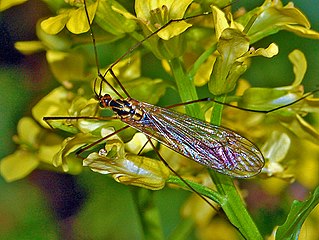
A crane fly is any member of the dipteran superfamily Tipuloidea, which contains the living families Cylindrotomidae, Limoniidae, Pediciidae and Tipulidae, as well as several extinct families. "Winter crane flies", members of the family Trichoceridae, are sufficiently different from the typical crane flies of Tipuloidea to be excluded from the superfamily Tipuloidea, and are placed as their sister group within Tipulomorpha.

Tipulidae is a family of large crane flies in the order Diptera. There are more than 30 genera and 4,200 described species in Tipulidae, common and widespread throughout the world.

Limoniidae is the largest of four crane fly families, with more than 10,700 species in more than 150 genera. Some studies have suggested it to be a paraphyletic group, with some limoniids being more closely related to Tipulidae and Cylindrotomidae than to other limoniids. Limoniid crane flies can usually be distinguished by the way the wings are held at rest. Limoniids usually hold/fold the wings along the back of the body, whereas other crane flies usually hold them out at right angles. Snow flies such as Chionea scita have no wings at all. Limoniids are also usually smaller than other crane flies, with some exceptions.

Nephrotoma appendiculata, the spotted crane fly, is a species of crane fly.

The Cylindrotomidae or long-bodied craneflies are a family of crane flies. More than 65 extant species in 9 genera occur worldwide. There are more than 20 extinct species.

Nephrotoma suturalis is a species of tiger crane fly in the family Tipulidae.

Limonia nubeculosa, also known as the short-palped cranefly, is a species of crane flies in the family of Limoniidae.
Dicranota maculata is a species of hairy-eyed crane fly in the family Pediciidae.
Tipula ignobilis is a species of large crane fly in the family Tipulidae.

Tipula longiventris is a species of large crane fly in the family Tipulidae.
Limonia novaeangliae is a species of limoniid crane fly in the family Limoniidae.

Limoniini is a tribe of limoniid crane flies in the family Limoniidae. There are about 7 genera and more than 1,400 described species in Limoniini.
Tipula chlorion is a species of large crane fly in the family Tipulidae.
Limonia immatura is a species of limoniid crane fly in the family Limoniidae.

Epiphragma solatrix is a species of limoniid crane fly in the family Limoniidae.

Chionea alexandriana is a species of snow fly (chionea) in the family Limoniidae. The species is common in the western mountains of North America, including Alberta, British Columbia, Washington State, Oregon, Idaho, Montana, Utah, and California. J.A. Chapman (1954), working in Montana, found them to be most abundant in snow fields at 3600-7000 feet elevation from November to April at temperatures ranging from 21-32 degrees F.
Limonia humidicola is a species of limoniid crane fly in the family Limoniidae. It can be found in Southern Canada, across the United States, and into Central America, commonly in shady, wet areas along streams.
Dicranoptycha nigripes is a species of limoniid crane fly in the family Limoniidae.
Limonia hardyana or flightless crane fly is a rare, wingless fly living in leaf litter on Oʻahu.

Trichocera maculipennis, commonly known as the winged winter cranefly, is a species of winter crane fly, of the order Diptera. First described by German entomologist Johann Wilhelm Meigen in 1818.












